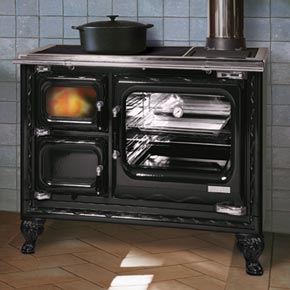|
Listen To The Article
|
 For all the intrepid pioneers who have left the grid behind and are making a go of it on their own, wood stoves are one of the best options available anywhere on the home heating scene. While dependence on the grid leaves us at the mercy of others, wood burning represents the ultimate example of self-sufficiency in action: if you are willing to get out there into the forest with your pickup, your chainsaw, your maul, a couple of wedges, and your trusty ax, laziness and a poor work ethic are the only things that will prevent you from putting up enough wood to keep your family comfy and toasty throughout the long cold winter. Self-sufficiency and independence are what true off-the-griddism is all about, and that is why so many homesteaders and preppers have chosen to install wood stoves in their homes to help them meet some or all of their cold-weather heating demands.
For all the intrepid pioneers who have left the grid behind and are making a go of it on their own, wood stoves are one of the best options available anywhere on the home heating scene. While dependence on the grid leaves us at the mercy of others, wood burning represents the ultimate example of self-sufficiency in action: if you are willing to get out there into the forest with your pickup, your chainsaw, your maul, a couple of wedges, and your trusty ax, laziness and a poor work ethic are the only things that will prevent you from putting up enough wood to keep your family comfy and toasty throughout the long cold winter. Self-sufficiency and independence are what true off-the-griddism is all about, and that is why so many homesteaders and preppers have chosen to install wood stoves in their homes to help them meet some or all of their cold-weather heating demands.
But let’s not kid ourselves here – cutting, splitting, and loading wood is grueling labor, and when you bust your hump trying to put up enough firewood to keep your home warm all winter, the last thing you want to see is a significant portion of your efforts go for naught, simply because your wood stove isn’t functioning as efficiently as it should. And even if you are buying wood instead of harvesting it on your own, you still work hard for your money, so the principle is exactly the same.
In some instances where wood is not being burned effectively, the mistakes could be yours, while in others there may be something wrong with your stove or with your overall wood-heating set-up. Of course the chances are that you won’t actually realize that your stove is gobbling up more wood that it really should need, and it will never even occur to you that two chords should have been enough to get you through the winter instead of the three you ended up using. But needless to say, that extra chord represents a lot of blood, sweat, and tears, and in the long run, off-the-gridders simply can’t afford to be that inefficient if they expect to survive out on the land.
So, you are asking, how can I cut the waste and inefficiency out of my wood burning practices? Or if you are planning on installing a wood stove soon, maybe you are asking, how do I make sure that I don’t make any mistakes that could hamper the effectiveness of my new heating unit? These are excellent questions, and they deserve excellent answers. So in honor of you and all those other hardy homesteaders who are dedicated to the proposition that “wood is good,” what follows are sixteen terrific tips that can help current and future wood stove owners wring every last drop of heat out of the wood they burn.
#1 – Avoid Stovepipe Angles
When it comes to flue pipe or stovepipe assemblies, the hard and fast rule is the straighter the better. Ideally, your piping should rise directly up into a chimney located right above it, but if you must angle your stove piping into the chimney, you would be much better off using two forty-five-degree elbows as opposed to one that bends sharply at ninety degrees. Straighter or less curvy runs set up stronger air drafts that promote more intense burning, and they also reduce the amount of creosote buildup (for those who don’t know, creosote is a flammable fireplace/woodstove residue that can cause chimney fires).
#2 – Put Your Wood Stove and Your Chimney in the Center of the Home
In winter, wood stoves and chimneys installed on outside walls are surrounded by warm air on the one side and cold air on the other. Consequently, their surface and inside air temperatures are cooler than room temperature, forcing your wood burning stove to work harder to overcome the extra chill. But with centrally positioned units, the stove and flue pipes are kept at room temperature all the time, while the chimney is also kept warmer, and this significantly reduces the burden on your stove once you start your fire. Additionally, centrally installed wood stoves will distribute heat throughout a room much more evenly.
#3 – Protect Your Chimney from the Wind
Winds whipping around the top of a chimney can cause backdrafts and interfere with proper updrafting. Therefore, steps should be taken to protect the top of your chimney from the wind. To do this you should install your wood stove near the center of the home, but not exactly at the center, so the chimney will penetrate the rooftop just behind the peak, preferably on the opposite side from the prevailing winds. Also, if you add a baffled cap to the top of your chimney, that will provide even more protection from stiff breezes and howling gales.
#4 – Check Your Door Seal for Leakage
Your wood stove door should fit snugly to keep the heat of the fire concentrated inside. To check it, you can lay a dollar bill across the door gasket lengthwise and then close the door with the bill still in it. If you can pull your money out with a quick tug, your door is too loose and you will want to tighten the latch described in your manufacturer’s instruction manual. Or, you can manually bend the hook welded to the body of the stove so it will grip the latch better when the door is closed. If your gasket shows signs of wear or damage, you will need to replace it immediately.
#5 – Check the Interior of the Stove for Signs of Warping
Some warping of the metal in a wood-burning unit is to be expected, and it will often have no effect on the overall operation of the stove. But if the internal steel parts of a wood stove become misshapen, that can cause the unit to perform below specifications by allowing exhaust to bypass the combustion system. For this reason, any interior part that can be replaced should be replaced if it shows signs of bending or warping.
#6 – Cut Your Firewood in a Variety of Sizes
Packing a wood stove fully and efficiently requires wood slices that come in different sizes. A good assortment should include cross-sectional cuts of three, four, five, and six inches (but probably not any bigger), and there should be some variety in the lengths as well so you will be able to fill all of the available space in your burning chamber.
#7 – Make Sure You Season Your Firewood for the Proper Amount of Time
People have a tendency to underestimate just how much moisture firewood contains. Nothing will cause your stove to function less efficiently than to fill it with green wood, so to avoid the problem you should begin the seasoning process in the early spring if you want your wood to be ready by the next fall. And if you plan to use any wood that is larger than normal, you will need to set it out to dry even earlier than that. Essentially, you should be harvesting your wood about a year in advance of when you actually plan to burn it, if you want to guarantee that it will be properly seasoned.
#8 – Season Your Wood Sensibly
Wood being dried should be stacked in open areas, under some kind of a suspended cover or roof, where it will be exposed to the sun and the wind. If you put it in a shed, garage, or outdoors in the shade, you will inhibit the seasoning process significantly. Of course, you have to be ready to wrap your wood completely with plastic if it rains, but if you add extra cover overnight you should only put plastic over the top and not over the entire stack. One thing you should never do is put wood on the ground to dry; instead, you will want to pile it on rails so that air can circulate underneath.
#9 – Choose the Types of Wood that are Appropriate for a Given Season
What you want are high-density, high-heat-content hardwoods like oak and maple for the winter, and softer, less potent woods like poplar, aspen, or spruce for the fall when temperatures are milder. Too much wood heat when it is not frigid outside is wasteful, and too little heat in the winter when Jack Frost gets really nasty will force you to compensate by burning extra wood or using back-up sources of heat more frequently.
#10 – Give Your Wood a Week to Warm Up
When burning season starts, you do not want to fill your house with firewood because of the moisture, sleeping insects, and mold spores it may be carrying. But you should try to keep about a week’s worth in the house at all times so it will have the chance to warm thoroughly before being thrown into the fire.
#11 – Use an Intelligent Kindling Scheme
Whether you are starting a fire from scratch or re-igniting one on an existing bed of coals, proper kindling technique is of course very important. To begin, you can place two pieces of split wood in a parallel position on opposite sides of a stove’s combustion chamber, and then stuff the pocket between them full of newspapers (save this step for last if you are working from an existing coal bed). Your smaller pieces of kindling can then be stacked on top of the original pieces of wood, but in a crosswise position that will suspend them directly over the paper. Any larger pieces of wood that you would like to add can then be stacked lengthwise on top of this second layer of kindling. With such a logical arrangement, things should take off quickly once you light the paper or after it is ignited by the coals.
#12 – Build from the Top Down
Here is an excellent technique for fire building that many wood enthusiasts swear by. With the top-down method, you will start out with a parallel arrangement of large pieces of wood across the bottom of the burning chamber, and working from that foundation you will then stack more layers of wood pyramid style one on top of the other, alternating between lengthwise and crosswise. Each layer of wood should be comprised of pieces that are incrementally smaller than those on the layer directly below, and your kindling and finally your newspaper should be placed on your pyramid’s apex, directly beneath the ceiling of the stove. After that, the only thing left to do is light the newspaper before you stand back and let nature run its course. With the top-down approach, you will be able to make a smooth transition from kindling fire to the real thing in a matter of minutes, and if you have done it correctly it should be at least a couple of hours before you will have to add more wood to replenish your roaring blaze.
#13 – Burn it Hot, Burn it Quick
The most efficient type of fire burns fast and clean, releasing the heat contained in the wood it consumes in bursts rather than in a steady stream. Slow-burning fires smolder inefficiently, and the hotter you can you make your fire, the more effective you will be at milking your wood supply for all it is worth. Rather than filling your stove full of thick wood and relaxing while it simmers for hours, you will get much more bang for the buck if you burn a few separate cycles over the course of the day. It may take a little more effort and attention to do it this way, but this is the way to go if you are serious about heating your home as efficiently as possible.
#14 – Get an EPA-Certified Unit
Admittedly, the federal government doesn’t do a whole lot of things well. But the standards they set for energy efficiency in household appliances are pretty useful, and you can expect any wood-burning stove that has been certified by the EPA to be at least 30 to 40 percent more efficient than an older model. It will be a heck of a lot easier to get fire insurance if you have an EPA-certified stove as well.
#15 – Build a Thermal Mass Wall Around Your Wood Stove
Thermal mass is the measurement of how much heat a substance can absorb and re-admit at a later time. Any time an object made of materials that have a high thermal mass is exposed to a heat source, it will continue to radiate warmth long after that source has been removed, which is why a thermal mass wall built around the perimeter of a wood burning stove is such a fantastic idea. Brick would probably be the most convenient and aesthetically appropriate choice, but masonry or concrete walls would work perfectly well if you wanted to go in that direction. In the fall and early spring in particular, if you had a thermal mass wall to recycle the heat you were producing, you could see dramatic reductions in the amount of wood you would have to burn to keep your house comfortably warm.
#16 – Recycle Your Wood Ash
Okay, so strictly speaking this is not a tip that will help you burn wood more efficiently. But we will include this suggestion anyway, because wood ash is full of healthy nutrients and can make an excellent lawn or garden fertilizer. It can also perform wonders in compost piles by helping to maintain neutral acid levels, and it can improve traction significantly when it is spread on icy driveways or sidewalks in the wintertime.
©2012 Off the Grid News
 Off The Grid News Better Ideas For Off The Grid Living
Off The Grid News Better Ideas For Off The Grid Living



